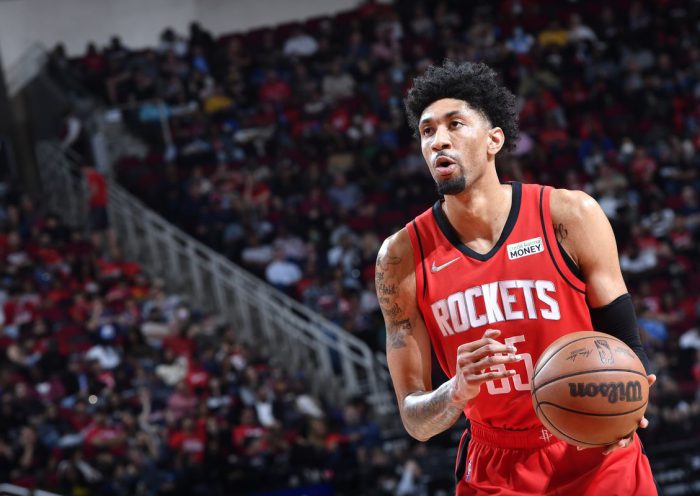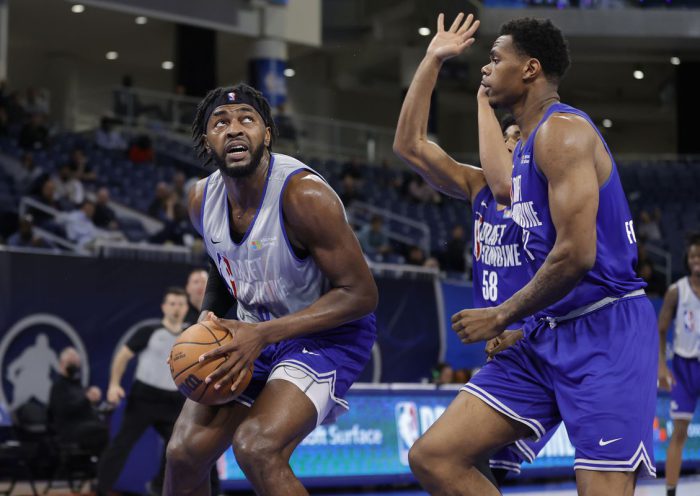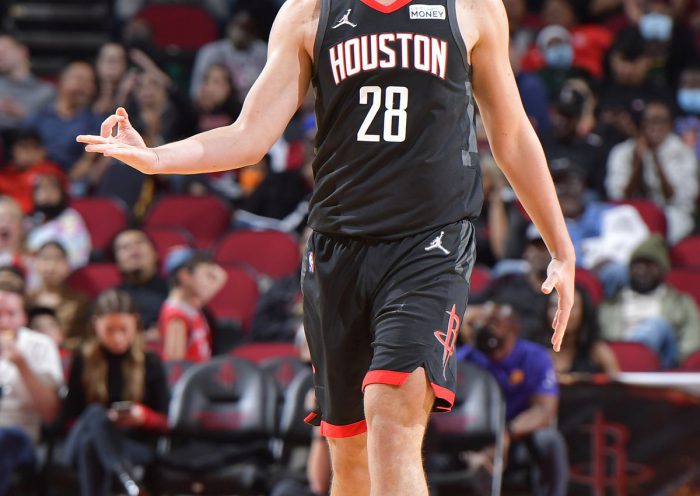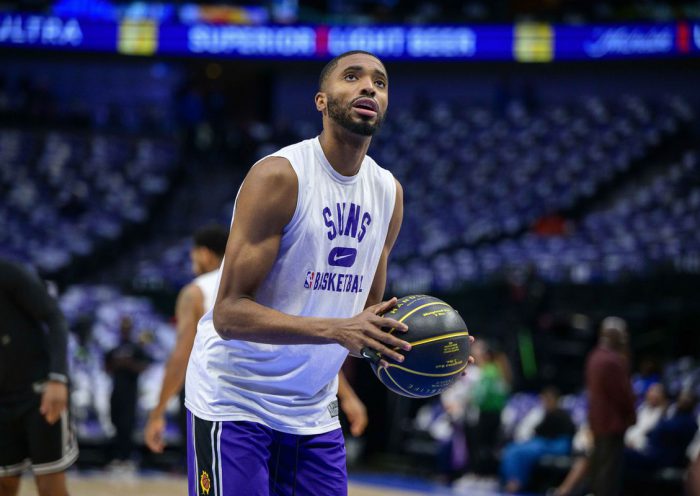2022 Orange Swingman Alternate Jersey Rebuilding the Prep-To-Pro NBA History: Class of 2011
When Amir Johnson’s name became part of the 2005 NBA group of draftees after Detroit selected the Westchester High School (Los Angeles) product with the 56th pick, no other true high schooler would hear his name called in such type of event up to these days. Truth be told, all of Satnam Singh (2015), Thon Maker (2016), and Anfernee Simons (2018) made it to the NBA straight out of high school, but their cases are the exception to the rule and all come with an asterisk attached to them.
The reality, though, is that NBA put a ban of the prep-to-pros pipeline leading up to the 2006 draft, making the members of the 2005 HS class the last ones able to jump-start their pro careers making a straight leap from high school to the Association. That, if you ask me, was a bummer. With that route cut out, prospects were mostly forced to make it to the NCAA ranks for a year before declaring for the draft. The latest developments regarding elite prospects getting ready for the pros, though, are watching them ditch college in favor of other options such as playing overseas (LaMelo Ball and RJ Hampton did it) or entering the G League as part of its Select Team (Jonathan Kuminga, Isaiah Todd, Jalen Green, Daishen Nix, and Kai Sotto will be there next season).
But what if the NBA had not banned the prep-to-pro route back in 2006? With the benefit of hindsight, I’ll go class by class (rankings by 247Sports Composite board) reviewing who could have made the jump straight to the NBA, who was ranked too high and could have flopped after such an eventual jump, who needed the most reps to hone their game, etc. Let’s get to it!
2011 HS Class: Top-10 Prospects
2011 Top-10 HS Prospects
While the class of 2010 had its two best prospects ranked no. 1 and no. 2, it wasn’t as top-heavy as the one preceding it in 2009 (all top-3 players then have 44+ Win Shares now and no other prospect ranked inside the top-25 has reached even 20 WS). But speaking of heavily-skewed HS classes, the 2011 also gets a high grade on that front. Anthony Davis completely unexpected growth made him the clear-cut best prospect in the nation—and with good reason. The Brow currently has 82.7 WS while playing in the NBA and that is twice the ma phoenix suns vintage jerseyrk from no. 4 Bradley Beal.
It is true that Austin Rivers and Michael Kidd-Gilchrist have disappointed a bit as pros, but they had 11.3 and 21 WS themselves, and two more players ranked booker suns jerseyinside the top-12 (Cody Zeller and Kentavious Caldwell-Pope) have 27+ WS. That’s pretty much it for this clase. Outside of the top-4 and those other no. 10 and no. 12 prospects, no one really stepped up his game through the years other than your typical under-the-radar guys: in this case, no. 31 Otto Porter (29.9 WS).
Scouting services didn’t screw things up here that much, or at least not when assessing their decisions in that moment: all but one top-16 player (no. 11 Josiah Turner) were named to the MCDAAG and the other kid to miss the classic was no.5 Quincy Miller but just because of an ill-timed injury.
Too bad for scouts themselves, this class was pretty much abominable in terms of overall value. The thing is, the NBA needs to keep pumping new talent onto the system on a yearly basis, which actually made possible for 20 of the 26 players from the 2011 class to even Phoenix Suns 9 Dan Majerle White Hardwood Classics Revolution 30 NBA Jerseys Cheaptually take a step into an court from the Association. Considering how the careers of those have gone, though, more than probably scouts were just taking fliers on these kids and throwing them to the wall to see if they could make at least some stick.
As silly as it sounds, no. 26 Michael Carter-Williams would end being the only Rookie of the Year of this class (in 2014) after jumping from the NCAA to the NBA one year later than one-and-dones Davis and Beal, who finished second and third in the award voting to Damian Lillard in 2013. And there is your glitch in the 2011-class system.
The three guys from the top-15 who could never make it to the NBA had wildly varying careers and stories. No. 8 LeBryan Nash (if you don’t make it even with that name then I don’t even know what’s wrong with you...) spent four years at Oklahoma State and then became a career-player in the Japanese basketball leagues after going undrafted in 2015Ricky Rubio Jerseys given his development got a little bit stuck. No. 11 Josiah Turner was seen as one of the—if not the—best point guards of the class, only to ruin his career with drugs and too much partying, which sent him packing to Hungary before he could even realize. Finally, no. 15 Myck Kabongo thought two years at Texas would be enough for him to being drafted, which... nope. Involved in some controv devin booker jerseyersy related to renowned agent Rich Paul, Kabongo could only play 11 games in his second year of college-ball before going undrafted in 2013 and is currently playing in the Danish pro-league.
In a similar way to what happened one year before, this class didn’t include any super-hidden gem down the prospect ranks. The three best players you can find digging deeper were all bunched in the 240-to-265 clip: Frank Kaminsky (12.4 WS), Josh Richardson (17.6), and DeWayne Dedmon (17.6), although although it took them a lot of time to become relevant among pros, with the former two not getting to the NBA until the 2016 season and Dedmon not having an reasonably good campaign until 2015 playing for the Magic before going through Golden State and Philly before that.
Which players WOULD have gone prep-to-pros?
Normally no more than four or five players made the jump straight out of high school to the NBA, and truth be told, this class would have fitted that trend like a glove. The fearful-four of Davis, Rivers, Kidd-Gilchrist, and Beal would have no-questions-asked tried their luck. That’s getting rid of the elephant in the room first, and in a fairly simple way.
Anthony Davis never made sense—nor he does these days for that matter as one of the best NBA players around. Davis was a small guard before his junior year. He was absolutely out of the picture until he grew into a 6-foot-10, 220-pound skinny-mammoth and started to dominate the competition on his way to becoming the no. 1 prospect in the country. Such was his talent that nobody had come closer to being as hyped as AD was since LeBron James, and probably no one surpassed those levels until Zion’s frenzy arrived a couple of years ago. I mean, Davis played one year in Kentucky but was taking SLAM cover pictures before the 2012 draft lottery donning every franchise jersey among those with chances at the no. 1 pick, to have all bases covered. Not a single player has been so locked into that no. 1 pick since LBJ again, for real. The prep-to-pros jump would have only meant that instead of New Orleans Davis would be calling Cleveland home—yes, he was good enough to have ousted Kyrie Irving from the no. 1 slot.
While it is true that Austin Rivers struggled a bit both in college and now in the NBA, the truth is that he had everything going his way as a teen. Rivers’s game was smooth as that of anyone when at high school and he also counted with the benefit of being the son of legend Doc Rivers. He averaged a pretty neat 29-6-2-2 line in his senior year, won a couple of state chips, and he would have definitely benefited from an early jump to the pros, perhaps more than anyone in the class—although he didn’t have a bad one-off season at Duke he was far from the best freshman in the nation finish just 22nd among that group of players in 2012.
Speaking of great freshmen, enter Michael Kidd-Gilchrist. I kid you not—Mike had been making the rounds of the higher echelon of basketball since 2008 when he was burning high school camps in his first prep-year, kept at it as a sophomore, was named to the SLAM All-American team as a junior, and again in his senior year. Kidd-Gilchrist played in all three summer showcases (MCDAAG, Jordan Classic and Nike Hoop Summit) averaging 14 points and 8 boards, got the MCDAAG MVP award, and claimed the 2011 Mr. Basketball USA. Not many players have such a trophy-laden HS career, and MKG—who got a chip with the Wildcats in 2012 and suns new jerseys 2022would be drafted 2nd-overall only behind AD—might have very well jumped early and still get drafted no. 2 only behind Irving in 2011.
Given what Beal accomplished in his high school days (National POY, MCDAAG, All-American) and his international exploits (U17 World Cup MVP in 2010), I lean toward Bradley Beal potentially jumping straight out of high school. At the end of the day, Beal was just another one-and-done who put up a neat 15-7-2 line with the Gators (yes, seven boards, two dimes that was). In that 2010 U17 WC Beal had to beat the likes of MKG, Quin Cook, and Andre Drummond to get the MVP. No joke this Beal.
Had I to pencil one more name in for a prep-to-pros jump, one appears to jump off the page more than the rest: LeBryan Nash. Nash was a bouncy kid from Texas and that was pretty much it. The pate from his high school days is an array of slam dunks coming from all places, and the upside he sNBA Backpacks and Bagshowed back then wasn’t actually something yet to be fulfilled, but rather all he had to show. He got to Oklahoma St. and put up a 13-5-2 line as a freshman, which wasn’t bad. What was bad? That his other three years in college finished with very similar averages and never ever got to really develop or reach the next level. He would have jumped because of the bells and whistles around his name getting out of high school, and perhaps some NBA franchise would have taken the flier with a second-round pick, but that would have been it. Sure, an NBA debut that really never arrived, but not much more.
Quincy Miller’s knee got busted thanks to an ACL in December 2010, cutting his chances at an early jump in half and forcing him—as if there wasn’t a rule in place already—to make the long route through the NCAA ranks. Marquis Teague was a bona fide point guard coming out of HS, but his attitude seemed a little bit naive and he was seen as a yet-to-mature prospect in all senses, so it’s hard to see him testing his luck early.
Which players COULD have gone prep-to-pros?
I might die alone on this island, but I have to give all of the love to Cody Zeller. Yes, that Cody Zeller, former Indiana Hoosier and Victor Oladipo’s partner in crime. No one was touching Anthony Davis as the best amateur in the nation playing basketball in 2012—freshman or not. But Zeller was the closest newcomer to Davis’ levels of play in the NCAA in his first year inside the collegiate circuit. Zeller finished his debut-year with the 18th-highest WS mark (6.8) and kept Indiana on the winning trail until they met eventual-champ Kentucky and loss 102-90. He finished his senior year averaging 25 points and 13 rebounds in high school and was clearly the best product from Indiana. He proved his worth in college, and after two years he became a 4th-overall pick in 2013. No doubts he’d have been a first-rounder if jumping from prep-to-pros.
There is no way in hell Otto Ported would have put his name in the eligible list leading up to the 2011 draft. He wasn’t a heralded prospect on the level of the top-4 ranked players, and he would have been lucky to even get drafted as a super-late second-rounder if at all. So he did well by attending college and staying in Georgetown a couple of years. It took him a bit to truly pan ouNBA Lawn and Garden Suppliest, but he’s always been a level-headed player, humble, responsible, and very solid once making it to the NBA so I believe an early jump and proper coaching could have him still active in the Association without much trouble. Jumping would have undoubtedly be too much of a risk, for sure, but he could have made it.
No need to mention how all of those top-4 kids, covered in the section above, would and pretty much could have jumped without any problem and still go on to have great rookie seasons among men in the L.
Which players did scouts WHIFFED on the most?
I guess LeBryan Nash makes for the most frustrating of cases. He looked good and has the physical attributes to become something important down the road, but he never developed as scouts expected even playing four years of NCAA ball. Each passing season of being stuck at the same level of play hurt him, and he had become stale when those college-days were over, making his chance at an NBA gig a dream too big to reach.
All of Miller, Teague, James Michael McAdoo, Adonis Thomas, etc were bigger whiffs in that they ended reaching the NBA but ultimately did between little and nothing once there. Miller played all of 69 games through three seasons, Thomas played six games for two teams in 2014, McAdoo somehow lasted four years in the NBA—and won two rings in the meantime with the Warriors...—, and Marquis Teague is more known for being Jeff’s brother than for his own game.
Austin Rivers (11.3 WS) has not reached the level some expected from him, but I’m Rivers’s no. 1 stan (sorry, haters) and I think he’s done more than enough to not consider him a whiff at all, blooming late as a great role player in the NBA. Kidd-Gilchrist’s (21 WS) career is a little bit on the verge of seeing him out of the league, but the Dallas Mavs brought him to the bubble and he keeps hanging in the L—not that playing for a stupidly bad Hornets helped him in his first seven seasons.
All ranked below the 240th spot, the true three whiffs of this class were the aforementioned no. 243 Frank Kaminsky (12.4 WS), no. 247 Josh Richardson (17.6), and no. 265 Dewayne Dedmon (17.6). Not as lowly ranked, which makes me a little more dubious about him being a real whiff, is Spencer Dinwiddie (18.6) whDennis Rodman Jerseyso ranked as the 132nd-best prospect in 2011. The truth is that Dinwiddie didn’t declare for the draft until 2014 and then had to endure a couple of seasons of irrelevance until he exploded in 2017 with Brooklyn, so it makes sense to have him a little low in the ranks coming out of HS.
Other not-so-lowly ranked kids from 2011 that went on to provide good value to those ultimately getting to roster them in the NBA: no. 98 Malcom Brogdon (16.8 WS), no. 93 Trey Burke (11.1), and no. 97 Pat Connaughton (9.8).



